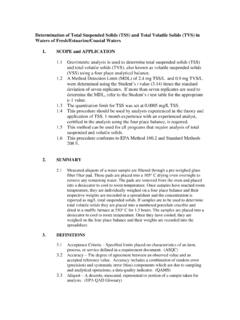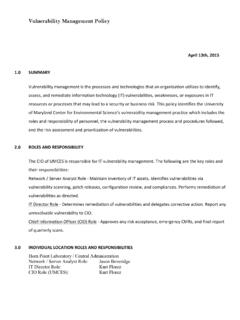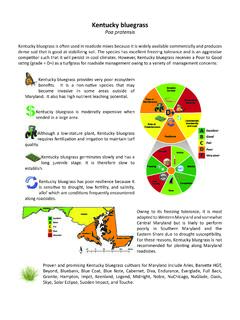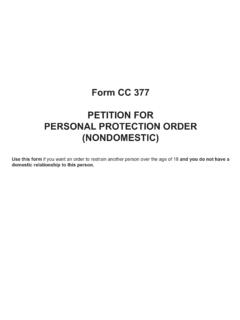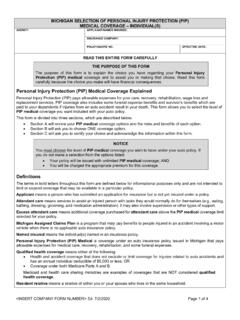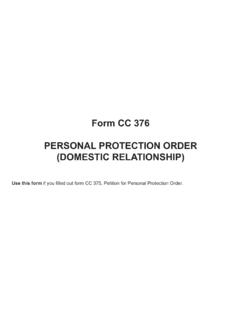Transcription of Personal Protective Equipment (PPE)
1 UMCES Safety: PPE (1 of 27) [8/19/2011 3:35:20 PM] Personal Protective Equipment (PPE) Safety Home> Personal Protective Equipment Personal Protective Equipment , or PPE, is your last line of defense against various workplace injuries. Please know when to wear PPE, how to wear PPE, and how to Levels of PPE protection PPE Hazard Assessment PPE Policy Summary PPE Policy Proper Use of PPE LEVELS OF PREOTECTIVE CLOTHING (PPE) The EPA designates four levels of protection in PPE: Level A: Provides the highest level of skin and respiratory protection available. This level is gas-tight, vapor-tight and splash-resistant; it is used in conjunction with a self- contained breathing apparatus (SCBA) or airline respirator.
2 Level B: Same as Level A but not vapor- or gas- tight. Level C: Features the some type of clothing as Level B, but has a lower level of respiratory protection . An air-purifying respirator is used in place of a SCBA. Level D: Offers the lowest level of protection , typically consists of a normal work uniform. Personal Protective Equipment HAZARD ASSESSMENT FOR HPL Auto Mechanic Carpenter Office Personnel Electrician Electronic Technician Outdoor Education Personnel Field Research Personnel Grounds keeping Housekeeping HVAC Personnel Lab Technician Machinist Safety Officer Maintenance Supervisor UMCES Safety: PPE (2 of 27) [8/19/2011 3:35:20 PM] Automobile Mechanic/ Automotive Shop HAND & ARM protection : Leather gloves and long sleeves and long pants when doing hot work.
3 FOOT & LEG protection : Steel-toed shoes extending above the ankles for protection from falling automotive, lawn Equipment , and boat parts, battery handling, as well as rolling tires and moving vehicles. Long pants must be worn when doing hot work. TORSO protection : Long sleeved non-dacron shirts when doing hot work. HEAD protection : Hard hat required when possibility of head injury from low overhead clearance or workmen working overhead. EYE protection : Goggles are required when working with batteries, gasoline, or solvents. Safety glasses or goggles must be worn when grinding, or performing hot work tasks.
4 Welding helmet or shaded goggles must be worn when welding or using torch. Whenever the potential exists for flying chips, burrs, or debris to enter the eye from striking one object against another, eye protection must be worn. HEARING protection : Ear plugs must be worn when grinding, running small engines or checking diesel generators. RESPIRATORY protection : Half face respirator is needed when spray painting, grinding painted boat bottoms or galvanized products. Contact the ESCO for requirements to wear a respirator. FLOTATION DEVICES: Must be on board vessels when operating in open waters.
5 Carpenter/carpenter shop HAND & ARM protection : Leather gloves should be worn to protect against splinters. Leather gloves and long sleeves and long pants should be donned when doing hot work. FOOT & LEG protection : Steel-toed shoes extending above the ankles shall be used for protection from falling lumber, Equipment , and pointed sharps protruding from lumber, etc. Long non-dacron pants should be worn when doing hot work. TORSO protection : Long sleeved non-dacron shirts should be worn when doing hot work. HEAD protection : Hard hat are required when the possibility exist for head injury from low overhead clearance or when workmen are working overhead Hard hats are also required when working around raised tow motor or tractor forklifts, with or without cargo.
6 Working on or around scaffolding will also require the use of hard hats. EYE protection : Goggles are required when working with batteries, gasoline, or UMCES Safety: PPE (3 of 27) [8/19/2011 3:35:20 PM] solvents. Safety glasses or goggles must be worn when sawing, grinding, or performing hot work tasks. Eye protection is also needed when performing tasks which may cause nails, loose debris, metal or plastic pieces to become dislodged and fly into the eye; some of these task are hammering, chiseling, scraping, etc. Welding helmet or shaded goggles must be worn when welding or using a torch.
7 HEARING protection : Ear plugs are required when sawing, grinding, or running small engines. RESPIRATORY protection : Half face respirator is needed when spray painting, grinding painted boat bottoms or other toxic painted products and when performing hot work on galvanized products. All toxic products, waste products or excess toxic material must be treated as hazardous waste and containment must be addressed. Contact the ESCO for requirements to wear a respirator. Management, Librarian and clerical staff HAND & ARM protection : Ergonomically correct chairs and workstations. FOOT & LEG protection : Ergonomically correct chairs and workstations TORSO protection : Ergonomically correct chairs and workstations EYE protection : Anti-glare or shielded computer screens Electrician or electrical work HAND & ARM protection : Leather gloves and long sleeves and long pants should be donned when doing hot work.
8 Special electrician s gloves shall be worn when working with 600 volts or above. Workers must be trained in the appropriate use of these gloves. HPL personnel are not permitted to work with any voltage over 460. FOOT & LEG protection : Steel-toed shoes extending above the ankles with electrical hazard protection shall be used for protection from falling motors, battery handling, and poor ground bonding. Long non-dacron pants are required when doing hot work. TORSO protection : Long sleeved non-dacron shirts should be worn when doing hot work. HEAD protection : Hard hats are required when the possibility of head injury from low overhead clearance or when workmen are working overhead Hard hats are also required when working around raised tow motor or tractor forklifts, with or without cargo and when on or around scaffolding.
9 EYE protection : Goggles are required when working with batteries, gasoline, or solvents. Safety glasses or goggles must be worn when grinding, or performing hot work tasks. Eye protection is also needed when performing tasks which may cause loose debris, metal or plastic pieces to become dislodged and fly into the eye; such as hammering, UMCES Safety: PPE (4 of 27) [8/19/2011 3:35:20 PM] chiseling, scraping, etc. Welding helmet or shaded goggles must be worn when welding or using a torch. HEARING protection : Ear plugs are required when grinding, running small engines or checking diesel generators.
10 RESPIRATORY protection : Half face respirator is needed when performing hot work on galvanized products. All toxic products, waste products or excess toxic material must be treated as hazardous waste and containment must be addressed. Contact the ESCO for requirements to wear a respirator. Electronic Technicians HAND & ARM protection : Leather gloves and non-dacron long sleeves and long pants should be donned when doing hot-work. FOOT & LEG protection : Steel-toed shoes shall be used for protection from falling Equipment and computers. Long, non-dacron pants are required when doing hot-work.


